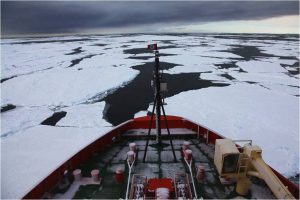
Those who are hostile to a buildup of carbon dioxide in the atmosphere have a friend in the ice and waves of the Earth’s coldest waters.
These two natural phenomena effectively gobble up a fourth or more of the planet’s CO2 and soak it into the sea. Discovering precisely how much of this air-to-sea exchange is occurring has a direct impact on global climate change models. But these air-sea fluxes, strongest near the Earth’s poles, have been poorly sampled, particularly in the Southern Ocean, due to data-gathering voyages being difficult, dangerous, and expensive.
Atmospheric scientist Scott Miller’s construction of equipment robust enough to withstand extreme environments in the Southern Ocean and Antarctic marginal ice zone has proved to be a significant advancement in gathering critical measurements. Now, air-sea exchange results from his team’s nine voyages over 18 months will be published on Aug. 16 by the journal Geophysical Research Letters (GRL).
“The main goal of our research was to determine how the efficiency of air-sea carbon dioxide exchange depends on wind-speed during high wind and wave conditions characteristic of the Southern Ocean,” said Miller. “Achieving this goal helps to improve the accuracy of calculated Southern Ocean—and global—carbon budgets.
“And, as it turned out, we also collected a lot of data in the Antarctic marginal ice zone. We were able to use the ice zone data to look at how gas transfer is affected by the presence of sea ice.”
The article, “Air-sea exchange of carbon dioxide in the Southern Ocean and Antarctic marginal ice zone,” is co-authored by Miller, a research associate in UAlbany’s Atmospheric Sciences Research Center, and doctoral candidate Brian Butterworth.
Since global climate models are extremely sensitive to how air-sea exchange is represented, Miller’s findings should ultimately increase all models’ accuracy. His team’s research upheld one long-term model on the rate of gas exchange that occurs during high wind and wave conditions over newer models which had suggested the rate of CO2 absorbed by the sea is much higher.
But his voyages also challenged some current models in another area. “In the sea ice zone, our results showed that gas exchange was in proportion to the amount of open water—data which did not support recent models suggesting that gas exchange is enhanced in the presence of sea ice,” he said.
The superior tools Miller and his team created for the voyages, conducted from January 2013 to June 2014 on the U.S. Research Vessel/Icebreaker Nathaniel B. Palmer, often operated unattended (without team members onboard), an approach never before achieved in the Antarctic. Fast-response sensors were placed 14 meters above the ocean surface, other monitors were located below deck at the bow, and several high-mounted cameras provided second-by-second photos that estimated ice cover.
Miller said his team now has a proposal to do similar work in the Arctic, except with higher resolution of the sea surface. “Also, we have proposed deploying a buoy-based system in the Southern Ocean as an alternative to using research vessels.”
Reference:
Brian J. Butterworth et al. Air-sea exchange of carbon dioxide in the Southern Ocean and Antarctic marginal ice zone, Geophysical Research Letters (2016). DOI: 10.1002/2016GL069581
Note: The above post is reprinted from materials provided by University at Albany.










